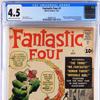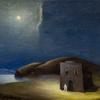'Cost of Revolution' Explored in Exhibition at Museum of the American Revolution This Fall
- PHILADELPHIA, Pennsylvania
- /
- May 26, 2019


Exhibit Explores the Physical and Emotional Toll of War and Revolution Through the Eyes of Irish Soldier Richard St. George
Tickets are now on sale for the upcoming special exhibition Cost of Revolution: The Life and Death of an Irish Soldier, which officially opens to the public Sept. 28, 2019 and runs through Feb. 17, 2020 at the Museum of the American Revolution, the exhibition’s exclusive venue, in Philadelphia.
Based on new discoveries made by the Museum’s curators, Cost of Revolution tells the untold story of Richard St. George, an Irish soldier and artist whose personal trauma and untimely death provide a window into the entangled histories of the American Revolution and the ensuing Irish Revolution of 1798.
“You may not have heard the name Richard St. George before, but you’ll be astonished by what his life can tell us about America and Ireland in the Age of Revolutions,” said Dr. R. Scott Stephenson, President and CEO of the Museum of the American Revolution. “This exhibit extends the Museum’s internationally acclaimed story-driven approach onto the global stage to examine the broader influence of the American Revolution through St. George’s remarkable personal journey.”
As a young officer in the British Army, Richard St. George crossed the Atlantic in 1776 to try and stop the growing American Revolution. He returned home to Ireland after surviving a severe headwound at the Battle of Germantown, near Philadelphia, in 1777.
Back in Ireland, he found his native country roiled by the effects of the revolutionary spirit sweeping across America and Europe. St. George became an outspoken critic of the growing movement to establish an Irish republic independent from the British Empire in the 1790s. A few months before the outbreak of the Irish Revolution of 1798, St. George’s tenants ambushed and killed him.
The 5,000-square-foot exhibition will chronicle St. George’s dramatic journey with more than 100 artifacts, manuscripts, and works of art from Australia, Ireland, England, and the United States, many of which will be on display in America for the first time. It will also present one of the largest collections of objects from Ireland’s 18th-century revolutionary history and war for independence ever displayed in Philadelphia.
Five portraits of Richard St. George—created over the span of 25 years—are known to survive and will be reunited in this exhibit for the first time since they left the possession of St. George’s descendants more than a century ago. Every known piece of surviving artwork by St. George himself—including cartoons, sketches from his military service in America, and a self-portrait—also will be assembled for the first time in this exhibit. Together, the portraits, cartoons, and sketches reveal the physical and emotional toll of revolution.

Cost of Revolution is included with regular Museum admission of $21 for general admission; $18 for seniors, active duty military, students and teachers; $13 for youth (ages 6-17), and free for ages 5 and under. Group rates are available. Audio tours are an additional $5. Tickets can be purchased by calling 215.253.6731 or at www.amrevmuseum.org.
Key Artifacts on Display:
- A portrait of Richard St. George by English artist Thomas Gainsborough (1776) that depicts him just before he shipped out for New York to fight against the growing American Revolution, on loan to the Museum from Australia’s National Gallery of Victoria (Melbourne).
- Three portraits of Richard St. George by Irish artist Hugh Douglas Hamilton (1790s) that show St. George as he struggled to manage the pain of the traumatic headwound he received during the American Revolutionary War. One of the portraits, on loan from the National Gallery of Ireland in Dublin, depicts him grief-stricken, mourning at his wife’s tomb. Hamilton painted this portrait as a movement for Irish independence, which St. George opposed, was on the rise.
- A signed self-portrait of Richard St. George, recently donated to the Museum, that depicts him in a forlorn landscape wearing a silk head wrap to cover the scars of his head wound. This portrait is a rare example of art created by a veteran of the American Revolutionary War that refers to personal pain sustained during the War.
- Paintings of the Battles of Paoli and Germantown by Italian artist Xavier della Gatta that St. George helped to create in 1782 to reflect on his participation in those battles. The paintings are in the Museum’s permanent collection.
- The British Army uniform coat and pistol that belonged to Richard St. George’s grandfather, on loan from the National Army Museum in London.
- The 1775 bound maps of the estate of Richard St. George in County Galway, on loan from the Galway County Council Archives in Galway, Ireland.
- A trephine, or skull saw, of the type that was used to operate on Richard St. George’s head following the Battle of Germantown, on loan from the Mütter Museum of the College of Physicians of Philadelphia.
- American illustrator Howard Pyle’s 1898 painting The Attack upon the Chew House which depicts the carnage of the Battle of Germantown, on loan from the Delaware Art Museum.
- The red uniform coat worn by British Army Lieutenant Ely Dagworthy on loan from Dumbarton House and the National Society of The Colonial Dames of America.
- The August 24, 1776 Leinster Journal, one of the first printings of the American Declaration of Independence in an Irish newspaper, on loan from the National Library of Ireland in Dublin, Ireland.
- A green uniform coat worn by Irish Revolutionary Henry Joy McCracken and a pike head carried by the United Irishmen during Ireland’s fight for independence from Great Britain in 1798, on loan from the National Museums of Northern Ireland (Ulster Museum) in Belfast.
- A rare silk flag carried by the Delaware militia that the British light infantry captured during the Philadelphia Campaign of 1777, on loan from the Delaware Historical Society.
- Richard St. George’s personal sketches from the American Revolutionary War, on loan from a private collection. One sketch depicts St. George being carted off the battlefield following his wounding at the Battle of Germantown in 1777.
- Lord Edward Fitzgerald’s ribbon and Theobald Wolfe Tone’s membership certificate from the United Irishmen, on loan from the National Museum of Ireland in Dublin. Both Fitzgerald and Wolfe Tone died while helping to lead the United Irishmen in their struggle for Irish independence from Great Britain in 1798. The ribbon, taken from Fitzgerald’s body after his death, served as a memento of the Irish Revolution and was used to inspire later Revolutionaries in South America.
For more information, visit www.AmRevMuseum.org or call 877.740.1776.
















